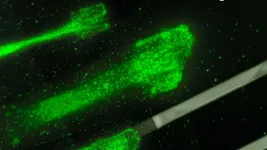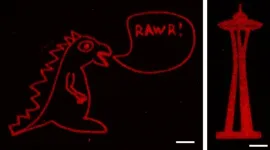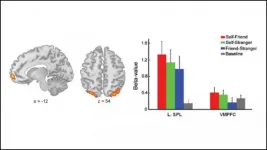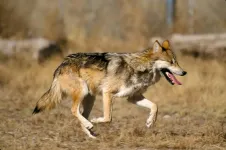(Press-News.org) Scientists in Australia have developed a method for the rapid synthesis of safe vaccines, an approach that can be used to test vaccine strategies against novel pandemic pathogens such as SARS-CoV-2, the virus that causes COVID-19.
Led by Professor Richard Payne at the University of Sydney and Professor Warwick Britton at the Centenary Institute, the team has demonstrated application of the method with a new vaccine for use against tuberculosis (TB), which has generated a powerful protective immune response in mice.
Researchers are keen to develop the vaccine strategy further to assist in the rapid pre-clinical testing of new vaccines, particularly for respiratory illnesses.
"Tuberculosis infects 10 million and kills more than 1.4 million people every year," said joint first author Dr Anneliese Ashhurst from the University of Sydney. "Historically, it is the leading cause of death worldwide from a single infectious agent. So far, a TB vaccine that is highly effective and safe to use in all populations has eluded medical science."
The only current vaccine for tuberculosis, the Bacille Calmette-Guerin vaccine, uses an injected live bacterium. It is effective in infants but has reduced effectiveness in adolescents and adults and poses significant health risks for immunocompromised patients, particularly for people living with HIV/AIDS.
Protein-based vaccines have been shown to be very safe, but they must be mixed with enhancers, or adjuvants, to make them effective, which is not straightforward.
Dr Ashhurst said: "The challenge is to ensure that our immune cells see both the protein and adjuvant simultaneously. To overcome this difficulty, for the first time we have developed a method that synthesises the protein with an attached adjuvant as a single molecule."
The vaccine strategy and synthetic technology could be deployed to rapidly generate new vaccines for pre-clinical testing for a range of diseases, the researchers say, including the respiratory pathogen that causes COVID-19.
Their results are published today in the Proceedings of the National Academy of Sciences of the United States of America.
HOW IT WORKS
In order for vaccines to be effective, they need to stimulate behaviour in protective T-cells that allows them to recognise the pathogen as an antigen, or foreign body. In the case of tuberculosis, our immune system needs to respond quickly to the bacteria that causes TB - Mycobacterium tuberculosis - to reduce infection in lungs.
Using the method developed by the Sydney scientists, an inhaled vaccine provides a low-dose immune-stimulating molecule - containing a synthesised bacterial protein attached directly to an adjuvant - to the immune cells in the lungs.
A major hurdle overcome by the scientists was the difficulty in fusing hydrophobic (water-repellent) adjuvants with a water-soluble protein antigen.
"We got around this problem of keeping hydrophobic and hydrophilic molecules together in a vaccine by developing a way to permanently bind the protein and adjuvant together as a single molecule using synthetic chemistry. Our approach overcomes the solubility problems faced by other methods," said Professor Payne from the School of Chemistry and Deputy Director of the ARC Centre for Innovations in Peptide & Protein Science (CIPPS).
The team says that synthesising an entire bacterial protein with attached adjuvant has not been achieved before.
Professor Britton from the Tuberculosis Research Program at the Centenary Institute said: "As well as providing a rapid method to develop a range of vaccines for pre-clinical testing, we expect that this pulmonary vaccination approach will be particularly beneficial for protecting against respiratory diseases."
He said: "We hope that an inhaled vaccine for tuberculosis using a protein-based immunisation will allow us to develop a universal and safe approach to combatting this deadly disease."
The other major advantage with this method is that vaccines for a range of diseases can be developed rapidly and safely in the laboratory.
"We don't need to grow the actual pathogen in the lab to make the vaccine," said Dr Ashhurst, who holds a joint position in the School of Chemistry and the School of Medical Sciences. "Using this new method, we can rapidly and safely synthesise highly pure vaccines in the lab and take them straight into animal models for pre-clinical testing."
INFORMATION:
Download photos of the researchers at this link.
Research paper available on request
Synthetic protein conjugate vaccines provide protection against Mycobacterium tuberculosis in mice, published in PNAS. DOI: 10.1073/pnas.2013730118
INTERVIEWS
Dr Anneliese Ashhurst | anneliese.ashhurst@sydney.edu.au
Professor Richard Payne | richard.payne@sydney.edu.au
Professor Warwick Britton | w.britton@centenary.org.au
MEDIA ENQUIRIES
Marcus Strom | marcus.strom@sydney.edu.au | +61 423 982 485
DECLARATION
The research was conducted with the support of the National Health and Medical Research Council of Australia (APP1044343) and the NHMRC Centre for Research Excellence in Tuberculosis Control (APP1043225).
Cell velocity, or how fast a cell moves, is known to depend on how sticky the surface is beneath it, but the precise mechanisms of this relationship have remained elusive for decades. Now, researchers from the Max Delbrück Center for Molecular Medicine in the Helmholtz Association (MDC) and Ludwig Maximilians Universität München (LMU) have figured out the precise mechanics and developed a mathematical model capturing the forces involved in cell movement. The findings, reported in the journal Proceedings of the National Academy of Sciences (PNAS), provide new insight for developmental biology and potential cancer treatment.
Cell ...
Imagine going to a surgeon to have a diseased or injured organ switched out for a fully functional, laboratory-grown replacement. This remains science fiction and not reality because researchers today struggle to organize cells into the complex 3D arrangements that our bodies can master on their own.
There are two major hurdles to overcome on the road to laboratory-grown organs and tissues. The first is to use a biologically compatible 3D scaffold in which cells can grow. The second is to decorate that scaffold with biochemical messages in the correct configuration to trigger the formation of the desired organ or tissue.
In a major step toward transforming this hope into reality, researchers at the University of Washington have developed a technique to ...
A brain region involved in processing information about ourselves biases our ability to remember, according to new research published in JNeurosci.
People are good at noticing information about themselves, like when your eye jumps to your name in a long list or you manage to hear someone address you in a noisy crowd. This self-bias extends to working memory, the ability to actively think about and manipulate bits of information: people are also better at remembering things about themselves.
To pinpoint the source of this bias, Yin et al. measured participants' brain activity in an fMRI scanner while they tried to remember the location of different colored dots representing themselves, a friend, or a stranger. The participants' fastest response ...
The core mass of the giant exoplanet WASP-107b is much lower than what was thought necessary to build up the immense gas envelope surrounding giant planets like Jupiter and Saturn, astronomers at Université de Montréal have found.
This intriguing discovery by Ph.D. student Caroline Piaulet of UdeM's Institute for Research on Exoplanets (iREx) suggests that gas-giant planets form a lot more easily than previously believed.
Piaulet is part of the groundbreaking research team of UdeM astrophysics professor Björn Benneke that in 2019 announced the first detection of water on an exoplanet located in its star's habitable zone.
Published today in the Astronomical Journal with colleagues ...
Indiana Jones and Lara Croft have a lot to answer for. Public perceptions of archaeology are often thoroughly outdated, and these characterisations do little to help.
Yet archaeology as practiced today bears virtually no resemblance to the tomb raiding portrayed in movies and video games. Indeed, it bears little resemblance to even more scholarly depictions of the discipline in the entertainment sphere.
A paper published today in Nature Ecology and Evolution aims to give pause to an audience that has been largely prepared to take such out-of-touch depictions at face value. It reveals an archaeology practiced by scientists in white lab coats, using multi-million-euro instrumentation and state of the art computers.
It also reveals an archaeology poised to ...
Irvine, Calif. -- Future climate change will cause a regionally uneven shifting of the tropical rain belt - a narrow band of heavy precipitation near the equator - according to researchers at the University of California, Irvine and other institutions. This development may threaten food security for billions of people.
In a study published today in Nature Climate Change, the interdisciplinary team of environmental engineers, Earth system scientists and data science experts stressed that not all parts of the tropics will be affected equally. For instance, the rain belt ...
Range anxiety, the fear of running out of power before being able to recharge an electric vehicle, may be a thing of the past, according to a team of Penn State engineers who are looking at lithium iron phosphate batteries that have a range of 250 miles with the ability to charge in 10 minutes.
"We developed a pretty clever battery for mass-market electric vehicles with cost parity with combustion engine vehicles," said Chao-Yang Wang, William E. Diefenderfer Chair of mechanical engineering, professor of chemical engineering and professor of materials science and engineering, and director of the Electrochemical Engine Center at Penn State. "There ...
Targeted neuromodulation tailored to individual patients' distinctive symptoms is an increasingly common way of correcting misfiring brain circuits in people with epilepsy or Parkinson's disease. Now, scientists at UC San Francisco's Dolby Family Center for Mood Disorders have demonstrated a novel personalized neuromodulation approach that -- at least in one patient -- was able to provide relief from symptoms of severe treatment-resistant depression within minutes.
The approach is being developed specifically as a potential treatment for the significant fraction of people with debilitating depression ...
More than 3,000 animal species in the world today are considered endangered, with hundreds more categorized as vulnerable. Currently, ecologists don't have reliable tools to predict when a species may become at risk.
A new paper published in Nature Ecology and Evolution, "Management implications of long transients in ecological systems," focuses on the transient nature of species' and ecosystem stability and illustrates how management practices can be adjusted to better prepare for possible system flips. Some helpful modeling approaches are also offered, including one tool that may help identify potentially ...
Researchers at the University of Adelaide have found new evidence about the positive role of androgens in breast cancer treatment with immediate implications for women with estrogen receptor-driven metastatic disease.
Published today in Nature Medicine, the international study conducted in collaboration with the Garvan Institute of Medical Research, looked at the role of androgens - commonly thought of as male sex hormones but also found at lower levels in women - as a potential treatment for estrogen receptor positive breast cancer.
Watch a video explainer about the new ...







